Approximately What Percentage Of The Us Economy Is Employed In The Service Sector During 2012?
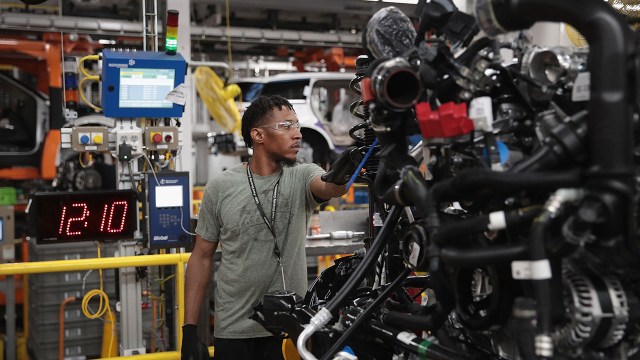
More than 157 meg Americans are part of the U.S. workforce, and many of them (but non all) will spend the Labor Day holiday weekend abroad from their desks, assembly lines and checkout counters. Every bit nosotros mark the twenty-four hour period, here's what nosotros know virtually who American workers are, what they exercise and the U.S. working surroundings in general.
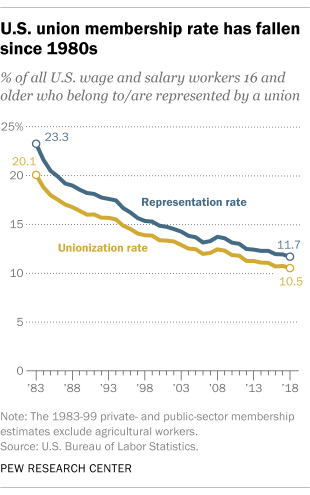
1Over the by 35 years, the share of American workers who belong to labor unions has fallen by about one-half. Union membership peaked in 1954 at nearly 35% of all U.S. workers (excluding the self-employed), but in 2018 the unionization rate was merely x.5%. (The share of workers represented by unions is a bit college, 11.7%, because about one.6 1000000 workers who aren't spousal relationship members are in jobs covered by a spousal relationship contract.) The bodily number of spousal relationship members was 14.7 million last twelvemonth, co-ordinate to the Agency of Labor Statistics (BLS). In 2012, marriage membership hit its everyman signal since the current data serial began in the early on 1980s, falling beneath fourteen.4 million, earlier turning modestly upward.
The manufacture with the biggest reject in the rate of matrimony representation from 2000 to 2018 was transportation and material moving, from 21.7% to xiv.5%. This industry includes a broad swath of occupations – from air traffic controllers to bus drivers to flying attendants. Unionization rates actually accept risen, albeit slightly and from low bases, in a few occupational groups: In legal occupations, for example, the unionization charge per unit rose from 5.1% in 2000 to 5.nine% last year.
In a 2018 Pew Research Centre survey, 51% of Americans said the decline in unionization has been generally bad for working people, while 35% regarded it every bit mostly skillful. More recently, 45% of respondents in a July 2019 survey said labor unions have a positive consequence on the mode things are going in the land; 28% described their impact equally negative.
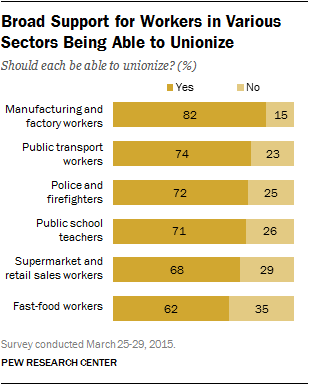
2Americans generally like unions and broadly support the right of workers to unionize. A bulk (55%) holds a favorable view of unions, versus 33% who concord an unfavorable view, co-ordinate to the 2018 Center survey mentioned above. In a 2015 survey, large majorities said manufacturing and manufactory workers (82%), public transportation workers (74%), police force and firefighters (72%) and public school teachers (71%) should have the right to unionize. Virtually six-in-ten (62%) said fast-food workers should be able to unionize, while 35% were opposed.
Matrimony members overall earned more than than non-union members in 2018 – $ane,051 per calendar week at the median compared with $860 among full-time workers. The gap in earnings reflects many factors, including differences in industry and occupation, firm size and region.
3Almost American workers are employed in the service sector. As of July, 107.viii million people (71% of all nonfarm payroll employees) worked in private service-providing industries, according to the BLS's most contempo employment study. Among the major service-manufacture sectors, the biggest was trade, transportation and utilities (27.8 million workers), followed past teaching and health services (24.3 million), professional and business organization services (21.five meg) and leisure and hospitality (16.7 million). Outside of the private sector service industry, nearly 22.v million Americans worked in government in July, with nigh two-thirds at the local level. Almost 12.9 million Americans worked in manufacturing.
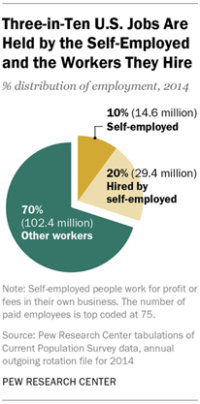
4Well-nigh 16 1000000 Americans are self-employed, co-ordinate to BLS data from July of this year. But the impact of the cocky-employed is wider: A Pew Inquiry Centre report found that self-employed Americans and the people working for them together accounted for 30% of the nation's workforce, or 44 million jobs in total in 2014. Simply almost a quarter of self-employed people (3.four meg) had employees of their own, though, and those who did have workers didn't take very many: Among self-employed people with employees, the median in 2014 was three and the average was eight.six.
The BLS estimate, derived from a survey of households, may undercount the self-employed. According to the Internal Acquirement Service, at that place were 25.five million nonfarm sole proprietorships in 2016 (these are all unincorporated businesses) – a count based on Schedule C filings of profit or loss from business.
vMillennials are now the largest generation in the U.S. labor forcefulness. Roughly a 3rd of Americans in the labor force (35%, or 56 million) are Millennials – those ages 23 to 38 in 2019. In 2016, Millennials surpassed Generation Xers (ages 39 to 54 in 2019) to become the single largest generational group in the U.S. labor strength. Compared with Babe Boomers, Gen Xers' identify as the dominant generation within the labor forcefulness was very curt-lived – just iii years.
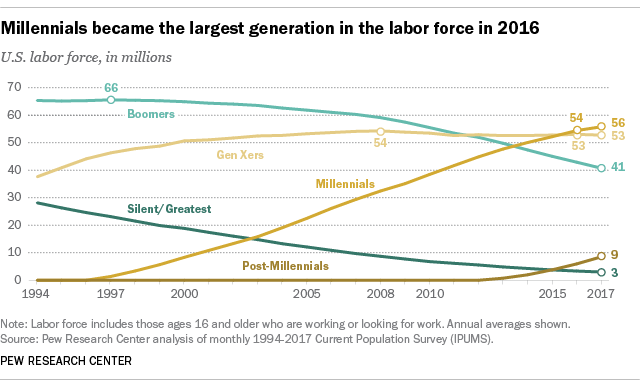
6American women earn 85 cents on the dollar compared with men, but that gap is narrower amid younger workers. In 2018, amongst workers ages 25 to 34, women'south earnings were 89% those of men, according to a Pew Research Center assay of median hourly wages that includes full- and role-time workers. Just evidence suggests that as women enter the responsibilities of parenthood their earnings fall farther backside same-aged male counterparts. Several other factors are believed to contribute to the persistence of the gender wage gap, among them the bear upon of broader family unit caregiving responsibilities, differences in the industries and occupations in which women and men work, workplace gender bigotry, and differences in workforce experience.
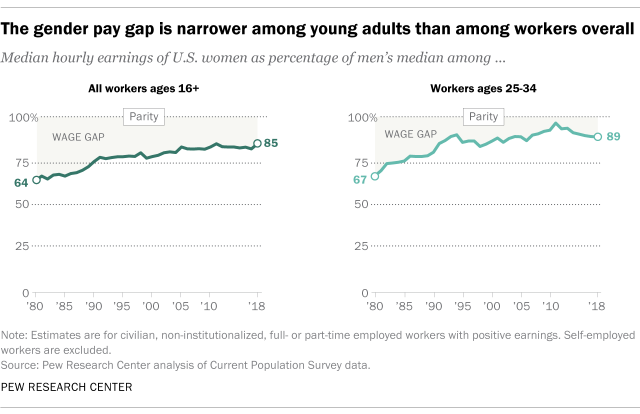
The gender gap is just ane of several gaps in earnings that narrate the American workforce. A divide Center assay from 2016, for case, found that white men had college median hourly earnings ($21) than every other racial or ethnic and gender subgroup except 1: Asian men, whose median hourly earnings were $24.
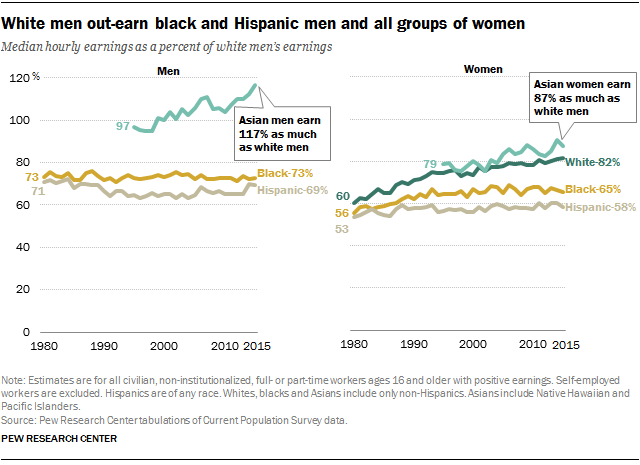
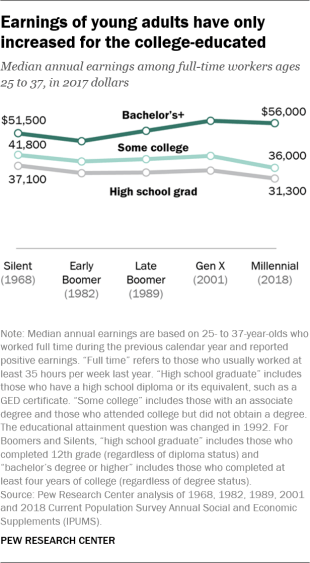
sevenThe wage gap between young workers with college degrees and their less-educated counterparts is the widest in decades. Despite the pressures of academic life, soaring college costs and crushing student loans, immature college graduates were improve off than their degreeless peers on many measures of economic well-being and career attainment, and to a greater extent than in the past. The Center's most recent analysis found that the median salary for college graduates ages 25 to 37 working full time earned was about $24,700 more than annually than employed young adults holding only a high school diploma. The pay gap was significantly smaller in previous generations.
While unemployment among all groups has fallen since the depths of the Great Recession to levels not seen since the 1960s, it's still true that the higher someone's educational attainment is, the more probable they are to accept a job. In July, co-ordinate to BLS data, only ii.ii% of adults with a available's degree or higher were unemployed, versus 3.six% for adults with simply a high school diploma and 5.1% for adults who didn't graduate from high school.
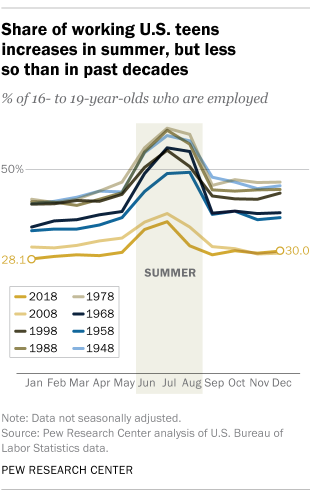
8A much smaller share of U.South. teens piece of work today compared with earlier decades. Teens spend 26 minutes a 24-hour interval, on boilerplate, doing paid work during the school yr, compared with 49 minutes about a decade ago and 57 minutes in the mid-1990s, according to a recent Pew Research Heart analysis of time utilize data from the BLS.
Teens also are working less during the summer. As recently every bit two decades ago, roughly one-half of U.S. teens could expect to be working for at to the lowest degree part of their summertime holiday. Only the share of teens working summer jobs has dwindled since the early 1990s: After bottoming out in 2010 and 2011 at 29.6%, the teen summer employment rate began rise again but was all the same only 34.half-dozen% in summer 2017. (From 1940 through the late 1980s, the teen summer employment rate more often than not fluctuated between 46% and 58%.) The decline of teens in summer jobs reflects an overall reject in youth employment in contempo decades, a trend that's as well been observed in other advanced economies.
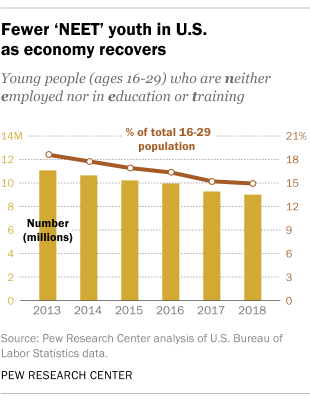
Another mode of looking at youth employment, or the lack thereof, is by focusing on "NEETs" – that is, young people who are neither employed nor in eastducation or training. In 2018, fourteen.8% of all Americans ages 16 to 29 – or nigh 9 million young people – were NEETs. In 2013, the first yr for which comparable data is available, there were about 11 meg NEETs in the U.S., or 18.5% of the sixteen-to-29 population. The Center'southward 2016 analysis found that in the U.S., the NEET youth population is more than female than male (57% to 43%). Two-thirds of U.S. NEETs have a high-schoolhouse pedagogy or less, and black and Hispanic 16- to 29-yr-olds were more likely than whites and Asians to be NEETs.
9More than older Americans are working than in previous decades. In July of this twelvemonth, 19.eight% of U.South. adults ages 65 and older – well-nigh 10.5 million people – reported being employed total- or office-fourth dimension, standing a steady increase since at least 2000. Older workers represented 6.half dozen% of all employed Americans in July, up from iii% in July 2000.
Americans ages 55 and older are working at much higher rates than in July 2007, presently before the Great Recession hitting. Employment rates have recovered for adults younger than 55, but have not exceeded pre-recession levels.
A Pew Research Center analysis of 2018 labor force data establish that 29% of Boomers ages 65 to 72 were working or looking for work – outpacing the labor market date of the Silent Generation (21%) and the Greatest Generation (19%) when they were the same age.
10Raising the federal minimum wage is popular overall, but there'south a abrupt partisan carve up on the consequence. Overall, 67% of Americans favor increasing the federal minimum wage from $7.25 an hour to $xv, according to a Pew Research Center survey from earlier this twelvemonth. But at that place's a stark separate between Democrats and Democratic-leaning independents, 86% of whom favor the idea, and Republicans and Republican leaners, 57% of whom oppose it.
In 2018, 1.7 million workers – 2.ane% of all hourly paid workers – had wages at or below the current federal minimum wage, co-ordinate to the BLS. Twenty-ix states, plus the District of Columbia and many cities and counties, have set their own higher minimums. Just wide disparities in the toll of living in different parts of the country – and even within private states – complicate the policy debate.
Note: This is an update of a post originally published Sept. three, 2015.
Approximately What Percentage Of The Us Economy Is Employed In The Service Sector During 2012?,
Source: https://www.pewresearch.org/fact-tank/2019/08/29/facts-about-american-workers/
Posted by: guoarron1960.blogspot.com


0 Response to "Approximately What Percentage Of The Us Economy Is Employed In The Service Sector During 2012?"
Post a Comment